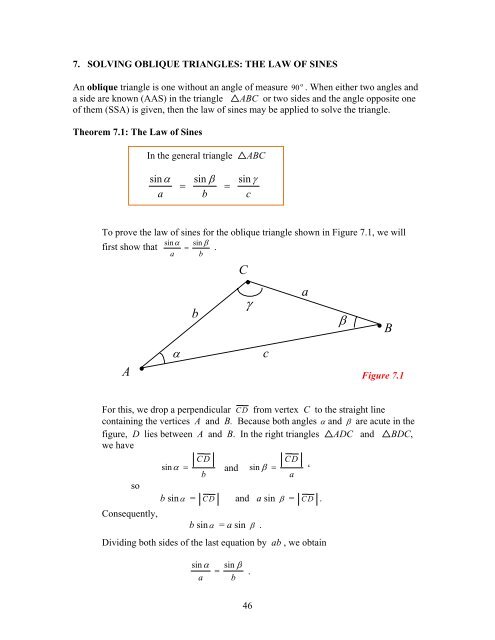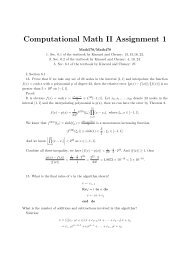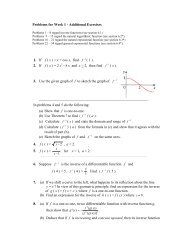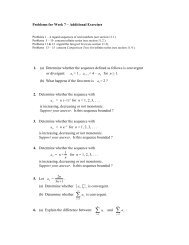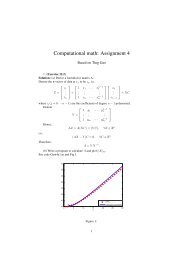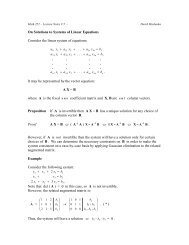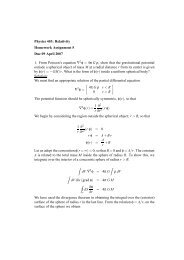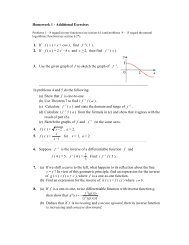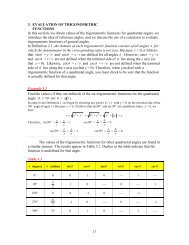Section 7: Solving Oblique Triangles
Section 7: Solving Oblique Triangles
Section 7: Solving Oblique Triangles
Create successful ePaper yourself
Turn your PDF publications into a flip-book with our unique Google optimized e-Paper software.
7. SOLVING OBLIQUE TRIANGLES: THE LAW OF SINES<br />
o<br />
An oblique triangle is one without an angle of measure 90 . When either two angles and<br />
a side are known (AAS) in the triangle ABC or two sides and the angle opposite one<br />
of them (SSA) is given, then the law of sines may be applied to solve the triangle.<br />
Theorem 7.1: The Law of Sines<br />
In the general triangle ABC<br />
sinα<br />
a<br />
=<br />
sin β<br />
b<br />
=<br />
sin γ<br />
c<br />
To prove the law of sines for the oblique triangle shown in Figure 7.1, we will<br />
first show that<br />
sinα sin β<br />
= .<br />
a b<br />
b<br />
C<br />
.<br />
γ<br />
a<br />
β<br />
.<br />
B<br />
A<br />
.<br />
α<br />
c<br />
Figure 7.1<br />
For this, we drop a perpendicular CD from vertex C to the straight line<br />
containing the vertices A and B. Because both angles α and β are acute in the<br />
figure, D lies between A and B. In the right triangles ADC and BDC,<br />
we have<br />
sin α =<br />
C D<br />
C D<br />
and sin β =<br />
b<br />
a<br />
‘<br />
so<br />
b sinα = C D and a sin β = C D .<br />
Consequently,<br />
b sinα = a sin β .<br />
Dividing both sides of the last equation by ab , we obtain<br />
sinα sin β<br />
= .<br />
a b<br />
46
.<br />
E<br />
C<br />
.<br />
γ ′<br />
a<br />
h<br />
l<br />
.<br />
A<br />
α<br />
b<br />
D<br />
β<br />
.<br />
B<br />
Figure 7.2<br />
Now to verify that<br />
sin α sin γ<br />
a c<br />
= , we observe that angle γ is obtuse. Let BE<br />
be<br />
the perpendicular from vertex B to the line l containing side AC . Let<br />
Then<br />
h<br />
o<br />
h<br />
sin γ ′ = = sin ( 180 −γ<br />
) = sin γ and sin α =<br />
a<br />
c<br />
so a sin γ = c sin α .<br />
sin α sin γ<br />
Thus, = .<br />
a c<br />
The proof of the law of sines in the case of an acute triangle ABC is similar.<br />
B E = h.<br />
Notice that the law of sines (Theorem 7.1) can be written in the alternative form:<br />
a<br />
sinα<br />
=<br />
b<br />
sin β<br />
=<br />
c<br />
sin γ<br />
.<br />
<strong>Solving</strong> a Triangle (AAS)<br />
If two angles of the triangle ABC are given, then the third angle can be found by using<br />
the relationship:<br />
o<br />
α + β + γ = 180 ;<br />
47
hence, the three denominators sinα , sin β , and sin γ can be found using a calculator.<br />
Now, if any one of the sides a, b, or c is also given, then the equations<br />
a<br />
sinα<br />
=<br />
b<br />
sin β<br />
=<br />
c<br />
sin γ<br />
can be solved for the remaining two sides.<br />
The following example indicates the procedure for solving a triangle when two angles<br />
and one side are given (or can be determined from the information provided.) Unless<br />
otherwise indicated, we shall round off all angles to the nearest hudredth of a degree, and<br />
all side lengths to four significant digits.<br />
Example 7.1 ---------------------------- ------------------------------------------------------------<br />
In ABC , suppose that α = 41 o<br />
o<br />
, β = 77 , and a = 74. Solve for γ , b, and c.<br />
B<br />
c<br />
β = 77 o<br />
a = 74<br />
Figure 7.3<br />
A<br />
o<br />
α = 41<br />
b<br />
γ<br />
C<br />
o<br />
Solution γ = −<br />
o<br />
o o<br />
77 = 62<br />
180 41 −<br />
a<br />
By the law of sines,<br />
sin 41<br />
hence, since a = 74,<br />
b =<br />
and<br />
c =<br />
a sin 77<br />
sin 41<br />
sin 41<br />
o<br />
a sin 62<br />
o<br />
o<br />
o<br />
=<br />
=<br />
sin 41<br />
o<br />
74 sin 77<br />
sin 41<br />
o<br />
74sin 62<br />
o<br />
o<br />
o<br />
b c<br />
= = ;<br />
o<br />
o<br />
sin 77 sin 62<br />
= 109.9<br />
= 99.59 .<br />
___________________________________________________________________________________________________________________________________________________________________________________________________________________________________________________________________________________________<br />
Note that in this case there is always a unique solution by the Angle-Side-Angle criteria<br />
for congruent triangles.<br />
<strong>Solving</strong> a Triangle (SSA)<br />
Because there are several possibilities, the situation in which you are given the lengths of<br />
two sides of a triangle and the angle opposite one of them is called the ambiguous case.<br />
For instance, suppose you are given side a, side b, and angle α in ABC . You might try<br />
to construct ABC from this information by drawing a line segment A C of length b<br />
and a ray l that starts at A and makes an angle α with A C (Figure 7.4). To find the<br />
48
emaining vertex B , you could use a compass to draw an arc of a circle of radius a with<br />
center C. If the arc intersects the ray l at point B, then ABC is the desired triangle.<br />
C<br />
b<br />
γ<br />
a<br />
Figure 7.4<br />
A<br />
α<br />
c<br />
β<br />
B<br />
l<br />
I As figure 7.5 illustrates, there are actually four possibilities if you try to construct<br />
ABC by the above method in case α is acute:<br />
( i ) The circle does not intersect the ray l at all and there is no triangle<br />
ABC (Figure 7.5a).<br />
( ii ) The circle intersects the ray l in exactly one point B and there is just one<br />
right triangle ABC (Figure 7.5b)<br />
( iii ) The circle intersects the ray l in two points B 1 and B 2 and there are<br />
two triangles A B 1 C and A B 2 C (Figure 7.5c).<br />
( iv ) The circle intersects the ray l in exactly one point B and there is just one<br />
acute triangle ABC (Figure 7.5d).<br />
Figure 7.5<br />
C<br />
C<br />
A<br />
α<br />
b<br />
a<br />
l<br />
A<br />
α<br />
b<br />
a<br />
.<br />
B<br />
l<br />
( a ) a < b sin α ⇒ no triangle possible ( b ) a = b sin α ⇒ one right triangle<br />
49
A<br />
α<br />
b<br />
C<br />
a<br />
. .<br />
B 1 B 2<br />
l<br />
A<br />
α<br />
b<br />
C<br />
a<br />
.<br />
B<br />
l<br />
( c ) b sin α < a < b ⇒ two triangles ( d ) a > b ⇒ one acute triangle<br />
II In case α is obtuse, then there are only two possibilities as shown in Figure 7.6.<br />
Figure 7.6<br />
C<br />
b<br />
A<br />
α<br />
a<br />
.<br />
B<br />
l<br />
C<br />
b<br />
A<br />
a<br />
l<br />
( a ) a > b ⇒ one triangle ( b ) a < b ⇒ no triangle possible<br />
In the ambiguous case, you can always use a calculator to solve the triangle ABC. Just<br />
use the law of sines,<br />
sinα sin β<br />
=<br />
a b<br />
⎛ sinα ⎞<br />
to evaluate sin β : sin β = b ⎜ ⎟<br />
⎝ a ⎠<br />
, 0 < β <<br />
o<br />
180 .<br />
50
⎛ sinα ⎞<br />
Recall that the sine of an angle is never greater than 1; hence, if b ⎜ ⎟ > 1, then this<br />
⎝ a ⎠<br />
trigonometric equation has no solution, and no triangle satisfies the given conditions. If<br />
⎛ sinα ⎞<br />
⎛ sinα ⎞<br />
o<br />
b ⎜ ⎟ = 1, then the equation has only one solution, β = 90 . If b ⎜ ⎟ < 1, then<br />
⎝ a ⎠ ⎝ a ⎠<br />
the trigonometric equation has two solutions. Namely,<br />
⎛ sinα ⎞<br />
β 1 = arcsin ⎜b<br />
o<br />
⎟ and β 2 = 180 − β 1 .<br />
⎝ a ⎠<br />
Once you have determined β ( or β 1 and β 2 ), you know two angles and two sides of the<br />
triangle (or triangles), and you can solve the triangle by using the methods previously<br />
explained. Even if there are two solutions β 1 and β 2 of the trigonometric equation for β,<br />
it is possible that only one of these solutions corresponds to an actual triangle satisfying<br />
the given conditions (see Figure 7.5d and Figure 7.6a).<br />
Example 7.2 ---------------------------- ------------------------------------------------------------<br />
Solve the triangle in each case.<br />
o<br />
1. α = 30 , a = 8, b = 5.<br />
Since α is acute and a > b there is only one acute triangle<br />
constructible.<br />
o<br />
sin β sin 30<br />
=<br />
5 8<br />
⎛ 5 ⎞⎛<br />
1 ⎞ 5<br />
⇒ sin β = ⎜ ⎟⎜<br />
⎟ =<br />
⎝ 8 ⎠⎝<br />
2 ⎠ 16<br />
A<br />
⎛ 5 ⎞<br />
o<br />
⇒ β = arcsin ⎜ ⎟ = 18.21 .<br />
⎝16<br />
⎠<br />
o o<br />
Then = 180 o o<br />
γ − 30 −18.21<br />
= 131 .79 .<br />
o<br />
o<br />
⎛<br />
o<br />
sin131.79 sin 30<br />
⎞<br />
Finally, ⎜<br />
sin131.79<br />
= ⇒ c = 8<br />
⎟ = 11.93.<br />
o<br />
c 8<br />
⎝ sin 30 ⎠<br />
C<br />
γ<br />
5 8<br />
o<br />
30<br />
c<br />
β<br />
B<br />
___________________________________________________________________________________________________________________________________________________________________________________________________________________________________________________________________________________________<br />
2. α =<br />
o<br />
30 , a = 5, b = 8.<br />
8<br />
Here α is acute and b sin a = < a < b 2<br />
⇒ there are two triangles constructible.<br />
o<br />
sin 30 sin β<br />
=<br />
5 8<br />
⎛ 8 ⎞ ⎛ 1 ⎞<br />
⇒ sin β = ⎜ ⎟ ⎜ ⎟<br />
⎝ 5 ⎠ ⎝ 2 ⎠<br />
4<br />
= .<br />
5<br />
A<br />
o<br />
30<br />
8 5<br />
5<br />
β 2<br />
B’<br />
β 1<br />
γ 2<br />
C<br />
γ 1<br />
β 1<br />
B<br />
51
Thus, β 1 = arcsin<br />
⎛ 4 ⎞<br />
⎜ ⎟<br />
⎝ 5 ⎠<br />
sin30<br />
5<br />
o<br />
= 53 .13 . Then γ 1 =<br />
o<br />
o<br />
sin96.87<br />
=<br />
c<br />
To find the measure of β 2 observe that<br />
o<br />
180 o o<br />
− 30 − 53.13 = 96 .87 and<br />
⎛ sin96.87<br />
⇒ c = 5 ⎜<br />
o<br />
⎝ sin30<br />
o<br />
o<br />
⎞<br />
⎟<br />
= 9.928<br />
⎠<br />
sin β 2 = sin ( π − β1<br />
) = sinπ ⋅ cos β 1 – cos π ⋅ sin β 1 = sin β 1 .<br />
o<br />
o<br />
Thus, β 2 = 180 − β 1 = 180 o o<br />
− 53.13 = 126 .87<br />
o<br />
o<br />
and γ 2 = 180 o o<br />
− 30 −126.87<br />
= 23 .13 .<br />
o<br />
o<br />
sin30 sin 23.13 ⎛<br />
o<br />
sin 23.13 ⎞<br />
Then = ⇒ c = 5 ⎜ ⎟ = 3. 928 .<br />
5<br />
o<br />
c<br />
sin30<br />
⎝ ⎠<br />
___________________________________________________________________________________________________________________________________________________________________________________________________________________________________________________________________________________________<br />
<strong>Section</strong> 7 Problems--------------- ------- -----------------------------------------------------------<br />
In problems 1 to 10 use the law of sines to solve each triangle ABC. Round off angles<br />
to the nearest hundredth of a degree and side lengths to four significant digits.<br />
1. a = 32, β =<br />
o<br />
38 , γ =<br />
o<br />
21 .<br />
2. a = 50, b = 30, α = 45 .<br />
3. a = 40, b = 70, α = 30 .<br />
4. b = 4.5, c = 9, γ =<br />
o<br />
60 .<br />
5. a = 31, b = 33, α = 60 .<br />
6. α = β = o 14 , c = 30.<br />
o<br />
7. α = 30 , a = 8, b = 5.<br />
o<br />
8. α = 30 , a = 5, b = 8.<br />
o<br />
9. β = 60 , a = 11, b = 12.<br />
o<br />
10. β = 60 , a = 12, b = 11.<br />
o<br />
o<br />
o<br />
52


